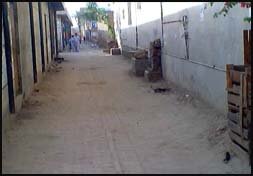

• This project will be marked as a first public
private partnership which is using
modern GIS technology for development
having essence of community involvement
• This Component Sharing development model is
included in the National Water and Sanitation
policy of the Government of Pakistan.
• Environmental condition, economic activities and
value of properties has increased.
• Neighborhood disputes over water
and sanitation are now a history
• This is the outcome of demonstration effect of
the lane with underground piped water and sewerage which reclaimed space for children’s
play.
· Necessities of people justify it
· Scanty resources and unlimited wants, which increases with population growth, provides basis to initiate this process
· Cost Effectiveness with appropriate technology and standards supported with OPP thumb rules procedures
· Free from complexities of bureaucratic procedures and channels
· Making it possible for the people to work for themselves, use their own resources and benefit from it
· Government inability to provide services to address people’s needs on time
· Time saving is one of the component
· Awareness has come to the government circle about successful community participation model
· Sense of ownership
· Spiritual belonging, sincerity, dedication and devotion have brought a behaviour change among GOs and other stakeholders
· Interaction with government organisations (GOs) for development of external systems for water supply, sewerage and social sectors interventions has been improved.
· As a result of the strenuous efforts, the government has been convinced that ASB approach is viable, therefore, it can work in the government sector.
· The local administration often visits ASB projects and evaluates performance keeping in view the pre and post situations of these projects for replication at scale.
· Legal protection is being provided to institutionalise ASB modality of development. This was possible due to visible successes of ASB, which has been recognised by the GOs.
· ASB has been given representation in the district development committee and other forums of GOs to voice its successes. Consequently, ASB’s access to GO’s resources has been enhanced. It is now possible to utilise the available government funding for external development in a planned manner.
· ASB’s approach has opened a way to build and sustain close co-ordination and cohesiveness between GOs and NGOs.
· Public has accepted the role of ASB, to address their issues in the field of integrated development.
· As a successful development model, ASB’s model is being extended to rural areas as well. The close co- ordination between GOs and NGOs has improved relationships with administration.
· In order to plan development in a systematic way, proper documentation of the available facilities, gaps and future needs are required to be made. It will help to prepare and implement effective integrated development plans.

